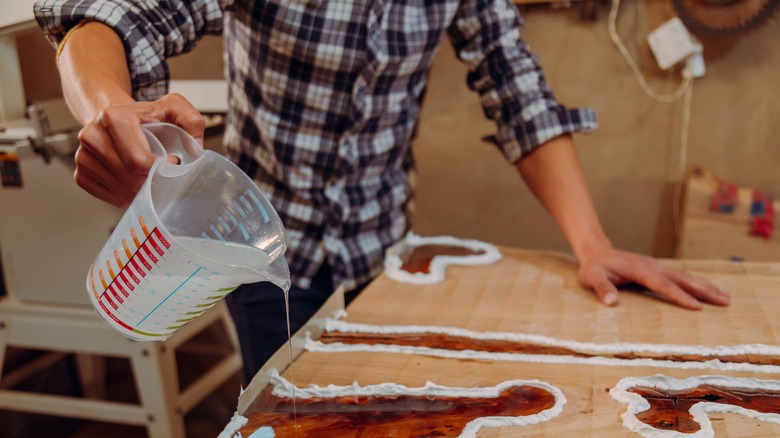Why You May Want To Think Twice Before Hopping On TikTok's DIY Epoxy Table Trend
DIY epoxy tables continue to surge in popularity, dominating social media feeds like TikTok and interior design blogs. DIY enthusiasts are captivated by the allure of creating their own custom, glossy masterpieces using epoxy resin, which is known for its exceptional durability. There are many reasons people are attracted to the DIY epoxy table route. It allows for personalization and gives one a chance to be creative and the opportunity to save some hard-earned cash compared to purchasing a ready-made piece.
However, creating a flawless epoxy table is a meticulous art, and many DIYers may find themselves facing unforeseen hurdles. Achieving a bubble-free, crystal-clear finish requires precise measurements, careful mixing, and impeccable timing during application. Controlling ambient conditions, such as temperature and humidity, becomes paramount to avoid imperfections like cloudiness or uneven curing. Choosing suitable wood, thoroughly preparing the surface, and preventing dust or debris from settling during the curing process are additional challenges that DIYers might underestimate. Epoxy's self-leveling nature can also turn into a double-edged sword, accentuating any flaws in the preparation process.
While the DIY route may seem enticing, it comes with its own set of challenges and potential pitfalls. So, if you've ever found yourself dreaming of following the DIY epoxy table trend by making a DIY coffee table, it might not be the wisest move. You may want to rethink your decision, at least until you get some practice with epoxy resin under your belt.
The challenges of making DIY epoxy tables
As TikTok creator @beautyandabuilder learned the hard way, achieving a high-quality epoxy table demands a skill set that extends beyond a basic understanding of crafting and simply watching DIY videos. First, she realized she didn't have enough epoxy for her project. In her futile attempt to spread the already inadequate amount of epoxy mixture evenly across the table, she ended up with a very thin layer of it. This miscalculation in the amount of epoxy required for @beautyandabuilder's project resulted in a splotchy design with parts of the wooden table visible in some areas due to the quick drying of the epoxy.
In general, epoxy resin becomes dry to the touch in 24 hours as it continues to cure. For epoxy resin table tops, you may need to wait 72 hours for the final layer of epoxy to dry. However, the drying or curing time can vary for different resin products and is also affected by certain conditions like the thickness of the resin layer, temperature, and ventilation.
It's crucial to do some research and familiarize yourself with the process before taking on a large project. Start with smaller, more manageable DIY epoxy resin projects like a side table for wine lovers, a TikTok-approved DIY clock, or any number of ways to incorporate resin in your home. With these smaller projects, you can hone your skills and troubleshoot potential issues. Make sure to follow precise measurements; work in a controlled, well-ventilated environment; and wear protective gear, as uncured epoxy resin is toxic.
